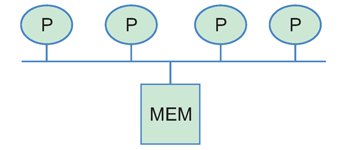| |
Shared memory MPs
- What is the communication protocol?
- Could be bus-based
- Processors share a bus and snoop every transaction on the bus

- The most common design in server and enterprise market
Bus-based MPs
- The memory is “equidistant” from all processors
- Normally called symmetric multiprocessors (SMPs)
- Fast processors can easily saturate the bus
- Bus bandwidth becomes a scalability bottleneck
- In `90s when processors were slow 32P SMPs could be seen
- Now mostly Sun pushes for large-scale SMPs with advanced bus architecture/technology
- The bus speed and width have also increased dramatically: Intel Pentium 4 boxes normally come with 400 MHz front-side bus, Xeons have 533 MHz or 800 MHz FSB, PowerPC G5 can clock the bus up to 1.25 GHz
Scaling: DSMs
- Large-scale shared memory MPs are normally built over a scalable switch-based network
- Now each node has its local memory
- Access to remote memory happens through load/store, but may take longer
- Non-Uniform Memory Access (NUMA)
- Distributed Shared Memory (DSM)
- The underlying coherence protocol is quite different compared to a bus-based SMP
- Need specialized memory controller to handle coherence requests and a router to connect to the network
|
| |
| |
| |
| |
| |
| |
| |
| |
| |
| |
| |
| |
| |
| |
|
|
|
|